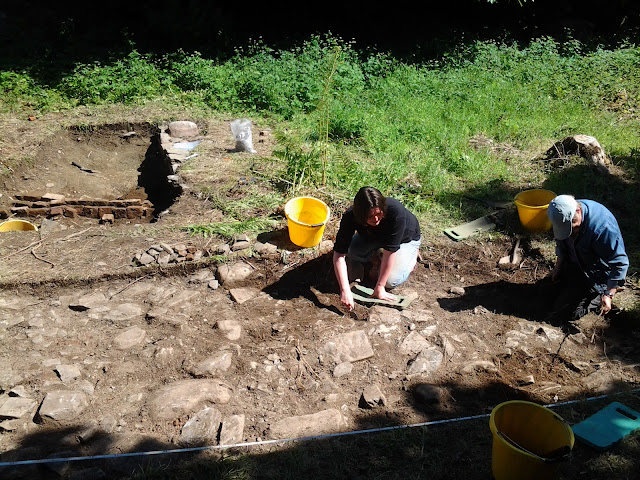A great day on site today. Although the weather threatened
to break for a while, we got away with it, another day without rain, so a good
day’s work put in. Great progress was made in all the trenches today.
A busy day was had in Trench 1 today! The layer that was
discovered yesterday which had wood within it was excavated and sampled.
Unfortunately, no more wood turned up. It is possible that the piece we found
(since it was found associated with nails) could be part of some garden
furniture. Below this, we found a sandy layer, containing a lot of broken
brick, but also a lot of bottle glass, which included some intact bases and a
neck piece. These have been provisionally dated to the 17th Century,
which is good news for us! Getting into the right time period! The removal of
these two layers has allowed us to investigate the base of our walls. The inner
mortared wall is built on the surface of the natural subsoil with no cut. The
flanker wall also appears to have been built on the natural subsoil, the surface
of which may have been leveled-up/off in preparation for its construction.
Between these two walls, there appears to be a short section of straight wall
joining them. Unfortunately this feature is running under untouched layers at
the edge of our trench. Hopefully time will permit us to excavate a little
further and investigate this wall.
 |
| Volunteers Li, Alish and Conall working in trench 1 with Grace |
Our two lines of bricks that were running through the
flanker wall are turning out to be the remains of mortared brick walls. This is
very interesting, as it was a quite unexpected feature. We are all looking
forward to seeing how they turn out when their excavation is completed.
 |
| Remains of mortared brick walls |
We also have rubble continuing in trench 1, as with
everywhere else! However, this rubble is still proving interesting. A fragment
of clay pipe bowl was found in one of those layers today, and seems to be
dating to the late 18
th century, which helps us to suggest a
possible time for this site’s abandonment. Also, the high concentration of
rubble that still remains in the centre of the inner wall could potentially
indicate that there was some sort of ornamental feature that once had pride of
place whenever this was being utilised as a garden feature.
 |
| Li and Alish working with Sapphire in trench 1 |
In Trench 2, the rubble layer was removed having been
planned yesterday. This appears to have simply come down onto another rubble
layer unfortunately! However, the wall does look like its continuing, running
into the section. So, typically, it ends somewhere in the metre or so of
unexcavated baulk between trench 2 and trench 3! If time allows, we may
excavate a little here to see where this wall goes.
 |
| The edge of our wall continuing in trench 2 |
In
Trench 3, the first thing that was completed this morning
was a quick clean-up of the trench before a photograph and plan of what we have
excavated down to. Then, a couple of the lads began to investigate our L-shaped
cut. This job hadn’t been completed by the end of the day, but this cut is
proving to be a bit of a head scratcher, we really aren’t sure what it is yet!
Hopefully tomorrow will shed some light on its function.
 |
| René and Jordan excavating the fill of the cut in trench 3 |
Once again, thanks to all our great volunteers, René,
Damian, Conall, Li, Alish and Jordan. Cheers for all your hard work!












































